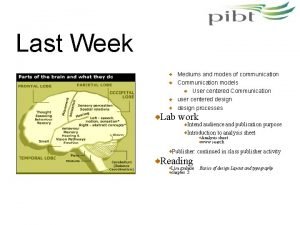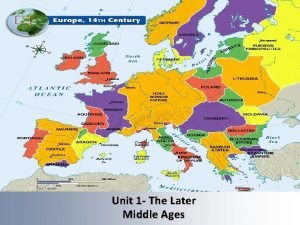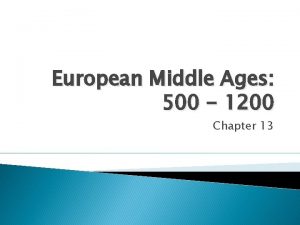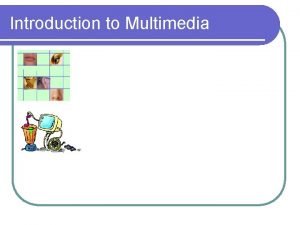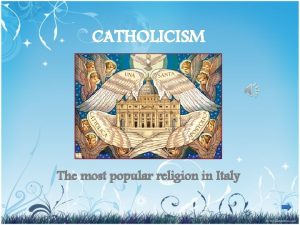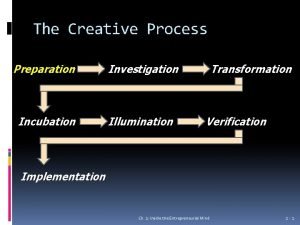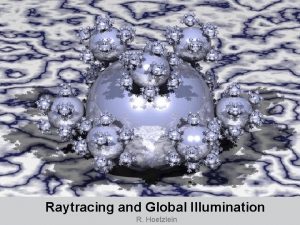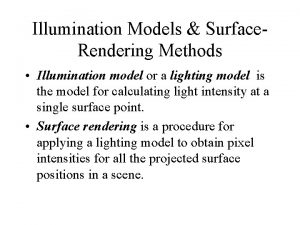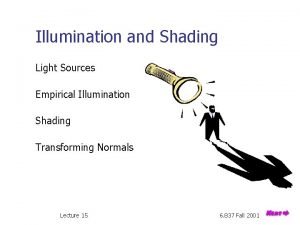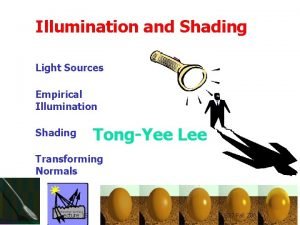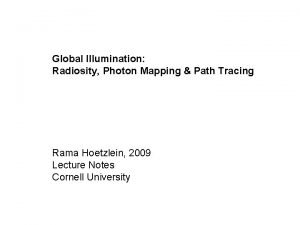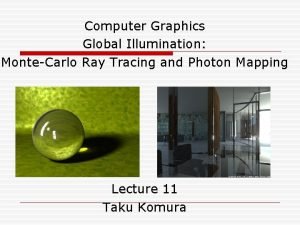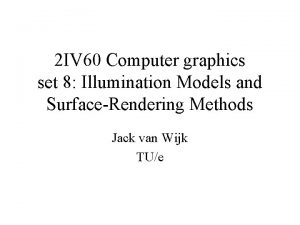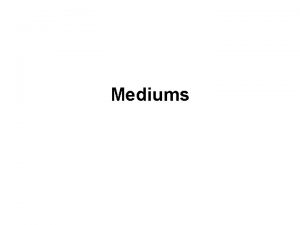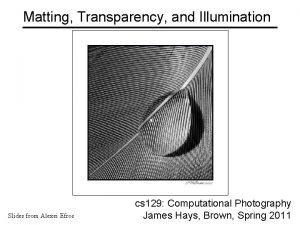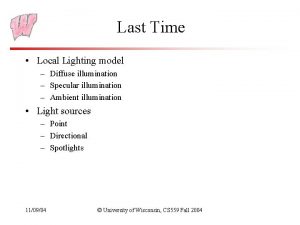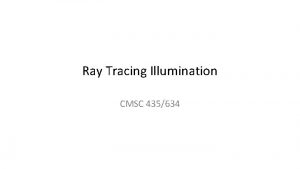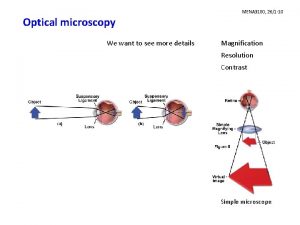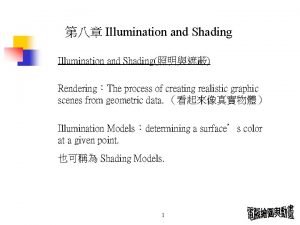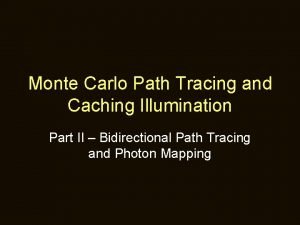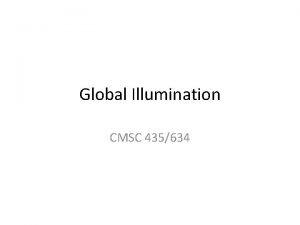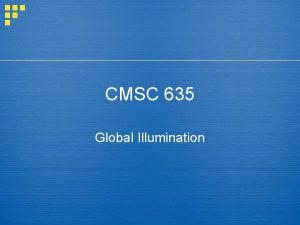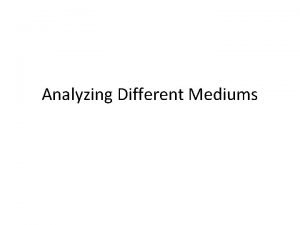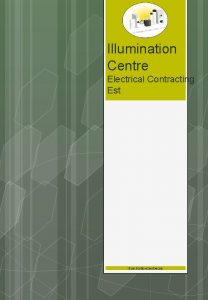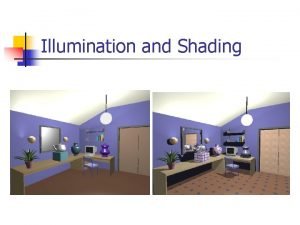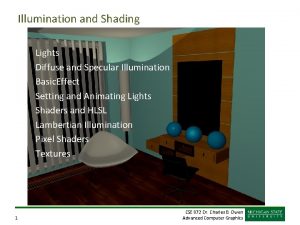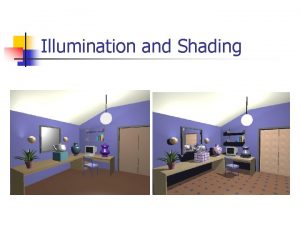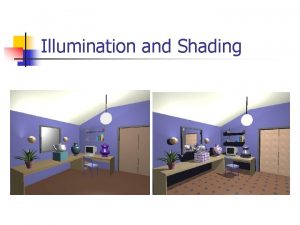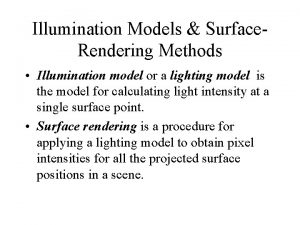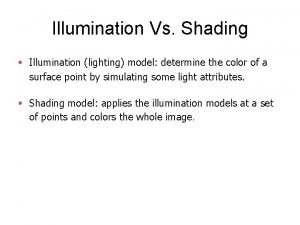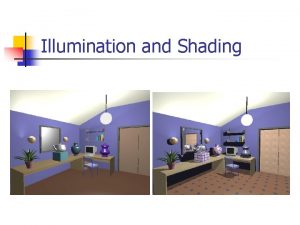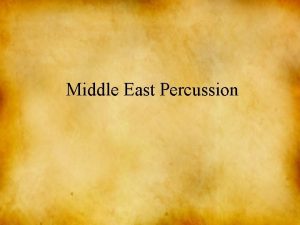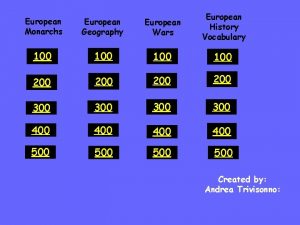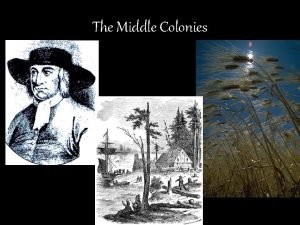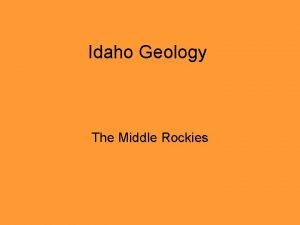Mediums Illumination most popular in the European Middle






























































- Slides: 62

Mediums

Illumination • most popular in the European Middle Ages in religious texts done by monks • paintings on parchment or vellum done with ink and color; decorated with gold leaf, jewels and other precious metals to represent their significant value • limitations: time consuming, monks were also limited to the size of the surface on which they were drawing • Illuminations done by hand were replaced by block books and the printing press that became faster and cheaper ways to produce books.

LIMBOURG brothers Les très riches heures du Duc de Berry: Fevrier (February) 1412 -16 Illumination on vellum, 22, 5 x 13, 6 cm Musée Condé, Chantilly

MINIATURIST, French Bible moralisée c. 1250 Illumination Österreichische Nationalbibliothek, Vienna

MINIATURIST, Flemish Mary of Burgundy's Book of Hours 1467 -80 Illumination on parchment, 22 x 16 cm Österreichische Nationalbibliothek, Vienna

Stained Glass Crucial characteristics of stained glass include elaborate designs and images using only basic colors of tinted glass pieced together using molten lead. Process Shards of colored glass are organized into images, and are then poured and formed using molten lead to create a pane. Limitations include size and cost. Too big compromises the structure and break-ability of the glass. it is also very expensive to create works of stained glass Stained Glass is most commonly found in church windows



Embroidery • 2 processes: Laid and Couched work, and the Stem-stitch technique • Laid and couched work supplies blocks of color and requires 3 steps. Stem stitching outlines all solid areas. • Although embroidery limits color versatility to the colors of the thread, it can be a useful tool in telling a story, using words and pictures as the story progresses. Materials used to create an embroidery vary from linen to wool to tiny beads and gems. • Embroideries can take a long time to make and must be kept in a safe place away from humidity and direct sunlight in order to preserve the bright dyed wooly goodness. • Seminal Works: Women of Burgundy, Normandy, and Bayeux; The Bayeux Tapestry, 1066 -82, Romanesque

UNKNOWN WEAVER, English The Bayeux Tapestry (detail) c. 1080 Wool embroidered on a linen background Musée de la Tapisserie de la Reine Mathilde, Bayeux

Engraving This is an intaglio (not a relief) process. It is the grooves, rather than the raised portions that are inked. 1. A drawing is cut into a copper plate using a burin, a metal tool with a sharp point, to remove the metal and create the lines of the drawing. 2. Ink is applied to the plate with a dabber or roller, and forced into the grooves. 3. The surface is cleaned with soft muslin. 4. A sheet of paper is laid over the plate. 5. The plate and paper are passed through a rolling press that applies pressure and forces the paper into the grooves to pick up the ink.

DÜRER, Albrecht Large Horse 1505 Engraving

VESALIUS, Andreas Anatomy 1543 Engraving Bibliothèque Nationale, Paris

DÜRER, Albrecht Adam and Eve 1504 Engraving

Etching • First a metal plate is coated with on both sides with varnish, which is resistant to acid. • Then the artist creates the image directly on the varnish by using a sharp needle to expose the metal. • Then the metal is covered with acid, which exposes the lines made with the needle. • By controlling the amount of time the metal is exposed to the acid, the artist is able to make either fine, shallow lines or heavy, deep lines. • The artist is limited by the size since a printing press can only be so big. But it also allows the artist to make corrections if mistakes occur.

Francisco Goya The Sleep of Reason Produces Monsters 1797 -98 Etching and aquatint, 216 x 152 mm

Rembrandt Faust 1650 -52 Etching, 209 x 161 mm Rijksmuseum, Amsterdam

Oil painting • Oil paintings utilize glazing, which is painting in layers on transparent oil. • Applying it in thin layers allows it to be translucent because oil paint comes in different levels of opacity, so you can either glaze it (like Van Eyck) or impasto it on (like Van Gogh). • The tiny brushstrokes are well blended and barely visible. This medium allows errors to be corrected while it is still wet because it is much slower to dry. The glazing is relatively transparent and allows for a glowing effect.

Caravaggio The Calling of Saint Matthew 1599 -1600 Oil on canvas, 322 x 340 cm Contarelli Chapel, San Luigi dei Francesi, Rome

EYCK, Jan van The Annunciation (detail) c. 1435 Oil on canvas transferred from wood, 93 x 37 cm

• • Vincent Van Gogh Starry Night 1889 Oil on Canvas

Oil on Wood Panel • This medium was used from large altarpiece to small portraits. • It was used by 15 th century Europe painters, especially Flemish painters. • Process of making an oil on wood panel painting: First the wood was sanded to make it smooth, then it was coated with a solution of chalk. Lastly fine linen was glued over the whole surface, finally the artist would paint with oil. • Oil on wood panel paintings took longer to dry than tempera and errors could be corrected while it was still wet. • The result of oil on wood is a smooth surface that betrayed brush strokes. • Using oil on wood panel allows to portray translucence. • -Translucence in an art piece could be made by applying oil in very thin layers. • The artist is only limited by the amount of space on the panel.

MASTER of Flémalle; Robert Campin Mérode Altarpiece c. 1427 Oil on wood, 64 x 63 cm (central), 65 x 27 cm (each wing) Metropolitan Museum of Art, New York

GRÜNEWALD, Matthias Nativity (detail) c. 1515 Oil on wood Musée d'Unterlinden, Colmar

Tempera • Tempera paints consist of colored pigments mixed with water and egg yolk. • It was mostly used in Italian Renaissance paintings and in medieval paintings. • The artist is limited by time due to the quick drying of the medium.

Paolo Uccello The Battle of San Romano 1430 s Tempera on wood, 182 x 220 cm

Sandro Botticelli, Birth of Venus c. 1482 Tempera on panel, 203 x 314 cm

Ink on Paper • Ink is pressed onto a piece of paper ever so carefully and skillfully to create a work of art. • There are virtually no limitations through the use of this art technique (ink on paper). The presence of the artist’s hand is made quite evident and visible with an ever so gentle method of creation and extraordinary uniqueness that varies from each work.

Qichang; The Qingbian Mountains, 1617, Ming dynasty.

Hui; A Thousand Peaks and Myriad, 1693, Qing dynasty.

Ink on silk • Silk was very expensive so only royalty would commission works on silk. • Silk comes from silk worms which were only found in China at the time. • Not having a consistent amount of silk limited the number of silk paintings.

Hundreds of birds admiring peacocks Yin Hong Ming dynasty.

Ladies Preparing newly woven silk Zhang Xuan Northern song Dynasty

Watercolors • The traditional and most common support for watercolor paintings is paper; other supports include papyrus, bark papers, plastics, vellum or leather, fabric, wood, and canvas. • Watercolor painting is extremely old, dating to cave paintings, and has been used for manuscript illumination since Egyptian times and in the European Middle Ages It first became popular as an art medium during the Renaissance. • Watercolors are not very durable at all, they are very sensitive to light. • They are most often smaller scale paintings.

DÜRER, Albrecht Young Hare 1502 Watercolor on paper, 251 x 226 mm Graphische Sammlung Albertina, Vienna

DELACROIX, Eugène Arab Fantasia 1832 Watercolour, 150 x 270 mm Musée du Louvre, Paris

Lithography • it was invented in the mid 1790's • it's based on the natural antagonism between oil and water • a print is made from a design drawn on a flat stone block with a greasy crayon. Then the ink is applied to the wet stone, and when printed, it adheres only to the open areas of the design • a limitation is that a print can't be to big in size • it allows for an artist to create fine art prints

Theodore Gericault Pity the Sorrows of a Poor Old Man Romanticism Yale University Art Gallery 1821

Francisco Goya The Divided Arena The Bulls of Bordeux (series of 4 lithographs) 1825 Romanticism Biblioteca Nacional, Madrid

Marble • The sculptor starts off with a big marble rock and then has to guild the rock into the form that the sculptor wants. The rock is very valuable and big. The sculptor uses metal tools called the mallet that is used to strike the chisel, the chisels and the pneumatic hammer. • Hard to sculpt a similar piece because you have to have a steady hand. In general, you have to have a very skillful steady hand.




Bronze • First there is a heat resistant clay core made then wax is wrapped around the core and detail is done on the wax with a tool. Once the cast is made around the wax, the wax is melted and drained. Molten wax is poured in the cast to harden around the clay core. • The technique limits large scale sculpture because it would cause more complexity in creating a large sculpture and cast, that's why majority of bronze sculptures are smaller than other sculptures made by different mediums.

Donatello David c. 1430 Bronze, height: 158 cm Museo Nazionale del Bargello, Florence

Donatello Equestrian Statue of Gattamelata 1447 -50 Bronze, 340 x 390 cm Piazza del Santo, Padua

Antonio del Pollaiuolo Hercules and Anteus 1470 s Bronze, height: 45 cm Museo Nazionale del Bargello, Florence

Terra Cotta • Low-fired clay – incised before firing • Used in ceramics or sculpting. Popular in Etruscan and ancient Roman times • Terra cotta is not as limiting as wood, stone marble or bronze. Artist can remodel as many times as needed until it is fired. • Terra cotta is fragile and scarce now. It must be preserved underground • Two seminal works: Head said to represent Usurper Yoruba C. 1200 -1300 CE & Soldiers from the Mausoleum Qin Dynasty

Bowl 1508 Terracotta, diameter 32 cm Metropolitan Museum of Art, New York

BENEDETTO DA MAIANO Christ and the Samarian Woman Terracotta, 41 x 77 cm Museum of Fine Arts, Budapest

mosaic • patterns or pictures are made by embedding small pieces of stone or glass (tesserae) in cement on surfaces such as walls and floors • mosaics is usually used to adorn public spaces, especially in churches; the small pieces of glass glitter as they reflect incident light • the artist is limited by the shape of the wall and by the technique itself which is extremely laborious: in order to create detail and subtle shading, the artist/craftsperson must use extremely small pieces of stone or glass • mosaic is very durable (unless there is an earthquake or bombing) • mosaic tends to appear in the earliest Christian churches

Pietro Cavallini Annunciation 1291 Mosaic Santa Maria in Trastevere, Rome

Michele Giambono The Visitation c. 1451 Mosaic Mascoli Chapel, San Marco, Venice

Coppo di Marcovaldo Christ in Majesty mosaic on the vault (detail) c. 1301 (installation) mosaic Baptistry, Florence

Calotype • Calotype- the first photographic process utilizing negatives and paper positives, invented by William Henry fox Talbot in the late 1830’s. It is paper coated with silver iodide. • Talbot came up with the name “calotype” from the Greek term for “beautiful image. ” • Talbot's process became the basis of modern photography. • “soliloquy of the broom” gives evidence of his conviction that photography might offer a creative artistic outlet for those without the manual talent to draw or paint.

"The Open Door"‘ 18. 8 x 23. 1 cm. By 19 th century English polymath William Henry Fox Talbot, an inventor of photography.

Daguerreotype • An early photographic process (developed from the camera obscure) developed by Louis Daguerre • A copper plate is coated with iodine, when the surface is exposed to light and dipped in a salt solution, an image is produced on the plate. • 3 -D quality • Made in the early 1800 s • Very realistic, they became relics for people • No copies, it’s a precious individual • It completely revolutionized the ability to realistically portray images

Louis Daguerre L’Atelier de l'artiste (The Artist’s Studio) 1837 Daguerreotype Société Française de Photographie, Paris

Nicholas H. Shepherd Abraham Lincoln 1846 Daguerreotype Library of Congress

Edgar Allan Poe William S. Hartshorn 1848 Daguerreotype Library of Congress

Wet Collodion Photography What is Collodion? Collodion= a thick liquid, made of nitrated cotton that has been dissolved in alcohol and ether How is the technique employed? A glass plate is coated with a mixture of light sensitive salts and collodion, once most of the liquid has evaporated the plate is submerged in a chemical compound (silver nitrate in early days, but with time the process changes) then QUICKLY placed into the camera for exposure. (Quickly, because the plate must be wet in order for the image to be captured). Once the plate has been exposed it must be QUICKLY brought to a darkroom to be bathed in an acidic solution that develops the image. The Benefits of Wet Collodion Technique The photographer can produce several prints from one plate in record time, or use the plate itself as a collodion positive (the desired image) vs. collodion negative. The plates are BIG!! Meaning bigger pictures!!!

• Limitations of the Technique A dark room is needed, meaning the technique is not very portable. The plates are huge and heavy!!! How is a photographer going to photograph nature? He/She is going to need a mule, maybe a couple of them. Exemplary Use
 Modes and mediums
Modes and mediums Sound will travel at different speeds in different mediums.
Sound will travel at different speeds in different mediums. Sound will travel at different speeds in different mediums.
Sound will travel at different speeds in different mediums. Map of europe in middle ages
Map of europe in middle ages European middle ages chapter 13
European middle ages chapter 13 The beatles became the most popular
The beatles became the most popular Most popular religion
Most popular religion Most popular lan technology
Most popular lan technology Popular sports in austria
Popular sports in austria Popular sports in lithuania
Popular sports in lithuania Internet is the world's largest
Internet is the world's largest Is plotter is a storage device
Is plotter is a storage device Multi media product
Multi media product Most popular religion in italy
Most popular religion in italy Difference between taungya and shifting cultivation
Difference between taungya and shifting cultivation National sport of poland
National sport of poland Kien thuc ngay nay is one of the most popular
Kien thuc ngay nay is one of the most popular Vray global illumination
Vray global illumination Illumination in creative process
Illumination in creative process 3 mirror gonioscopy
3 mirror gonioscopy Parts of slit lamp
Parts of slit lamp Raytracing vs rasterization
Raytracing vs rasterization Loading bench in darkroom
Loading bench in darkroom Illumination engineering notes pdf
Illumination engineering notes pdf Illumination model
Illumination model Light direction
Light direction Illumination formula
Illumination formula Path of illumination map
Path of illumination map Dark field
Dark field Jeffrey shapiro mit
Jeffrey shapiro mit Global illumination algorithms
Global illumination algorithms Illumination model in computer graphics
Illumination model in computer graphics Poe global illumination
Poe global illumination Illumination
Illumination Local lighting examples
Local lighting examples Laser illumination of aircraft
Laser illumination of aircraft Direct illumination
Direct illumination Define ambient occlusion
Define ambient occlusion Advanced global illumination
Advanced global illumination Illumination
Illumination Posterior subcapsular cataract
Posterior subcapsular cataract Illumination concepts
Illumination concepts Kohler illumination system
Kohler illumination system Illumination and shading
Illumination and shading Global illumination vray
Global illumination vray Siggraph
Siggraph Hình ảnh bộ gõ cơ thể búng tay
Hình ảnh bộ gõ cơ thể búng tay Lp html
Lp html Bổ thể
Bổ thể Tỉ lệ cơ thể trẻ em
Tỉ lệ cơ thể trẻ em Voi kéo gỗ như thế nào
Voi kéo gỗ như thế nào Tư thế worm breton
Tư thế worm breton Chúa sống lại
Chúa sống lại Môn thể thao bắt đầu bằng từ chạy
Môn thể thao bắt đầu bằng từ chạy Thế nào là hệ số cao nhất
Thế nào là hệ số cao nhất Các châu lục và đại dương trên thế giới
Các châu lục và đại dương trên thế giới Công thức tính độ biến thiên đông lượng
Công thức tính độ biến thiên đông lượng Trời xanh đây là của chúng ta thể thơ
Trời xanh đây là của chúng ta thể thơ Mật thư tọa độ 5x5
Mật thư tọa độ 5x5 Làm thế nào để 102-1=99
Làm thế nào để 102-1=99 độ dài liên kết
độ dài liên kết Các châu lục và đại dương trên thế giới
Các châu lục và đại dương trên thế giới Thể thơ truyền thống
Thể thơ truyền thống
